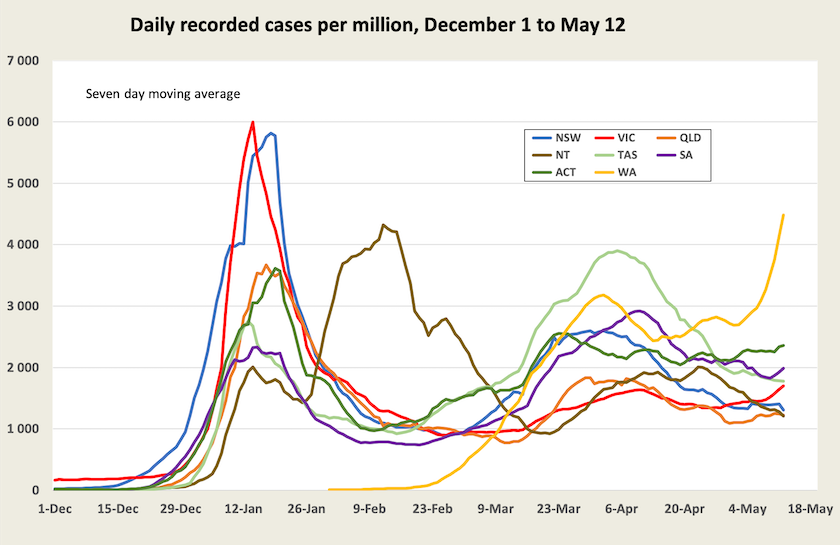The pandemic
Growing infections, 15 000 deaths a year, and increasing stress on public hospitals
Cases rising again
As is often the case, public opinion and reality are moving in different directions.
The general view is that Covid-19 is receding, and that we can all go about business as usual, with just a few nods to public health requirements. We observe life around us – only a few people are wearing masks, more people are going to large entertainment events, we experience Covid ourselves or among our friends with only mild consequences – and relax.
The reality is that cases are creeping up again, as shown in the graph below.

National figures mask some significant differences between states and territories. Western Australia, which avoided the December-January Omicron surge and delayed opening its borders, is now experiencing a surge. In most states and territories case numbers are falling, particularly in New South Wales, but they are rising in Victoria. The Guardian’s Covid-19 tracker, which has a great deal of state data, shows that in Victoria cases are rising strongly in outer suburbs of Melbourne – broadly the same regions that were the source of so much difficulty in the very first outbreak.

According to reported figures, which are probably out by a significant factor because of asymptomatic and unreported cases, 29 percent of people in New South Wales have been infected in the Omicron wave and on the other side of the continent 19 percent of people in Western Australia have been infected. Assuming these figures are out by a factor of 2, around 60 percent of people in New South Wales and 40 percent of people in Western Australia have been infected, with other states and territories in between.
Nationally, perhaps half of all Australians have managed to avoid infection so far, which means there are many people yet to be infected. That’s confirmed by the fact that each day about 45 000 cases are detected from 100 000 tests reported to authorities.
Even if, in New South Wales perhaps, the virus is finding it harder to infect new people, we are certainly not through it. Re-infections are possible, particularly as vaccination effectiveness and natural immunity wane, and new variants may be just around the corner.
Deaths holding for now, but still far too high
Deaths are hovering around 40 a day, or 15 000 a year. That’s almost a 10 percent increase in our normal annual deaths of around 160 000.
For every death there are more people on ventilation; for every person on ventilation there are more people in intensive care; for every person in intensive care there are more people in hospital with Covid-19, adding to stress in an already over-stretched hospital system. When hospitals are treating Covid-19 cases, other cases are being pushed down the line. In Western Australia ambulance ramping has become a serious problem.
According to official figures, the case-specific death rate has risen a little, from around 0.06 percent a month ago to around 0.10 percent now. That is from one death in about 1600 cases to death case in about 1000. That may be because some cases are not being reported (i.e. the denominator is understated), or because more people with inadequate or no vaccination are dying. For example, in Western Australia, while the unvaccinated account for only about 1 percent of the population, they comprise 27 percent of hospital patients with Covid-19.
We should also remember that death is only one outcome of Covid-19. “Long Covid” is still a nasty disease.
Vaccination – mind the gap
Differing reported infection rates in different states and territories may reflect different vaccination rates. When we look at charts and tables of vaccination levels and rates, such as those presented in the ABC’s vaccination tracker, we don’t notice much difference between states and territories. But what counts most significantly in terms of the load on hospitals and the number of deaths is the number of people not vaccinated.
The presentation in the chart below shows not only a contrast between the uptake of two- and three-dose vaccination, but also significant state differences, with Queensland, New South Wales and South Australia all revealing a significant proportion of people who are not yet fully vaccinated with three doses. Queensland and South Australia are also the states with comparatively low rates of vaccination among indigenous Australians.

The rest of the world
The US last week notched up its one-millionth Covid-19 death. On the other side of the geographical and political divide North Korea reported its first Covid-19 outbreak. It may be a good idea to defer your winter holiday plans for travel to Wonsan Beach Resort.